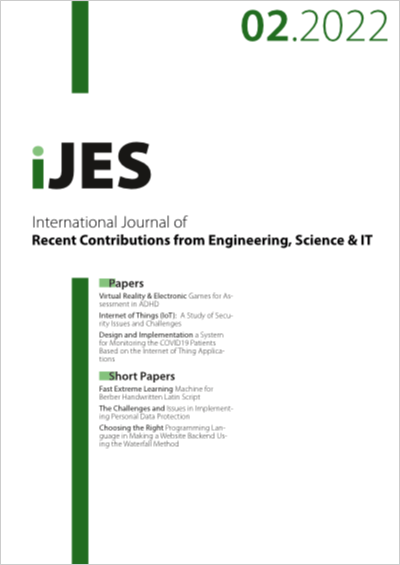Fast Extreme Learning Machine for Berber Handwritten Latin Script
DOI:
https://doi.org/10.3991/ijes.v10i02.30663Keywords:
Character Recognition, Extreme Learning Machine, Machine learning, Amazigh scriptAbstract
This article deals with the problem of Berber handwritten character recognition using Extreme Learning Machine. This paradigm has gained significant attention in pattern recognition field thanks to its efficient learning speed and its high accuracy. In this paper, we have used a fast Extreme Learning Machine to recognize efficiently the Latin Berber characters. So, the proposed ELM has been trained over a Berber-MNIST dataset containing images of Amazigh alphabets. This algorithm learns much faster than traditional popular learning algorithms thanks to the use of JAX library which contains several functions to reduce the execution time of our solution.
The simulation results show that the handwritten recognition system based on our developed extreme learning machine decreases computational cost and reduces the time required for the whole recognition process. Furthermore, the developed ELM achieves a high performance in terms of recognition accuracy.
Downloads
Published
How to Cite
Issue
Section
License
Copyright (c) 2022 Mokrane Kemiche, Sadou Malika, Bousba Nassima

This work is licensed under a Creative Commons Attribution 4.0 International License.
The submitting author warrants that the submission is original and that she/he is the author of the submission together with the named co-authors; to the extend the submission incorporates text passages, figures, data or other material from the work of others, the submitting author has obtained any necessary permission.
Articles in this journal are published under the Creative Commons Attribution Licence (CC-BY What does this mean?). This is to get more legal certainty about what readers can do with published articles, and thus a wider dissemination and archiving, which in turn makes publishing with this journal more valuable for you, the authors.
By submitting an article the author grants to this journal the non-exclusive right to publish it. The author retains the copyright and the publishing rights for his article without any restrictions.
This journal has been awarded the SPARC Europe Seal for Open Access Journals (What's this?)


